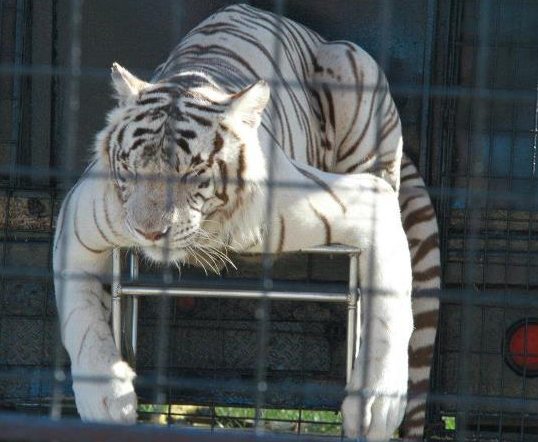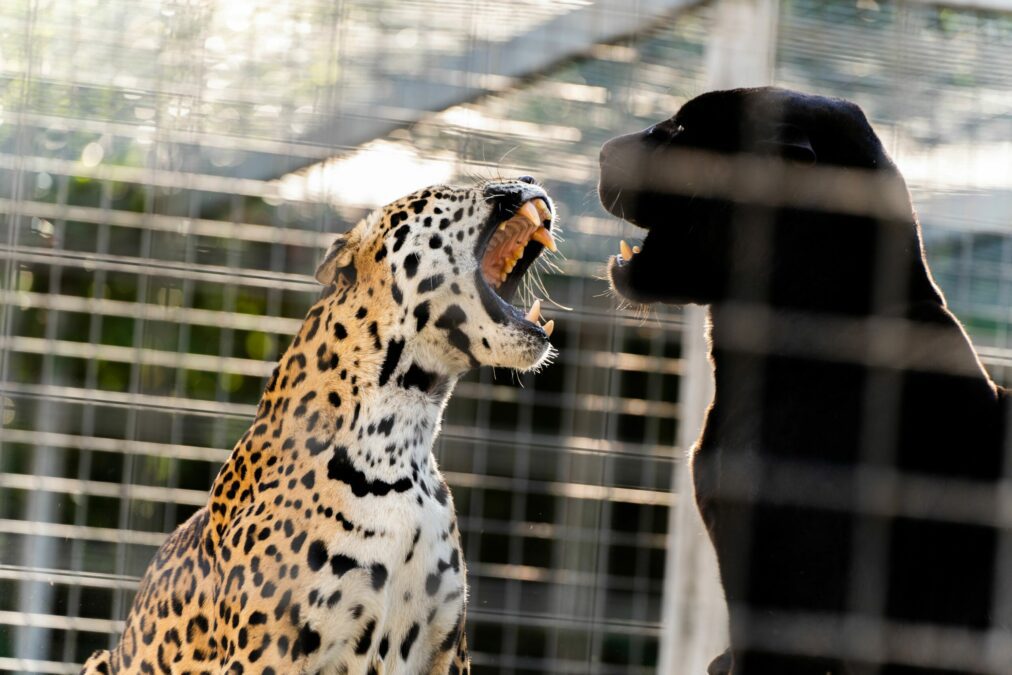How can I help when I see animal abuse?
What should I do when a fair, circus or cub petting act comes to town?
One thing that is very helpful, if visible, is to get pictures of the transport equipment and how the cats are kept when not performing. Also get photos of the semi. In particular with the truck is whether there is obviously ventilation. I find it best to take a number of photos if possible because where the cats are and what position they are in can affect whether the photo best shows the cramped quarters. With respect to the performance, look in particular for any use of any kind of whip or other instrument, and whether at any point the cats are cowering or resisting. Ears flattened back or eyes squinting means the cat is scared or mad. The latter is harder to catch with camera versus video, but possible sometimes.
Unlike the cub petting, where at least in theory there is a age limit, it is pretty hard for a performing act to break USDA rules as long as they have the cats behind a barrier. The only things we know of that we can look for are stress, discomfort, any obvious health issues like cuts, missing hair patches (ringworm), ribs showing, limping, diarrhea.
If an opportunity arises to talk with any of the staff, the following questions come to mind:
– flatter them by acting like it is amazing what they do, and then ask how do you train them to do that? Usually they say positive reinforcement. Ask for details, because despite what they say, cats will not perform reliably just based on reward training.
– this may give you away, but if you saw cowering, you might ask why they do that.
– note that people really seem to enjoy the show – then ask if they do a lot of shows; how many of these shows do you do in a year?
Other things YOU can do whenever possible is:
– photograph the vehicles if possible photograph the license plate and any signage on the vehicles or trailers
– photograph or collect and scan any literature
– photograph their advertising posters
– if it is allowed video their presentation
– get names, address, phone numbers, email addresses of the facility or venue hosting the traveling exhibit
– get the name of the company or person who owns the animals
– count the animals, jot down the animals names
– if they say they do that to support conservation as them to specify how
– print out these images as posters and fliers https://bigcatrescue.org/posters/
Some people have been able to get photos of animals in cages with an empty water dishes. If you are able to watch the animal throughout the day and see that they are being deprived of water, we can help you file a complaint with USDA.
Lastly, it’s great if you can get someone to go with you. Two people observing behavior of the cats or hearing information is more difficult to dispute than one person, when you write up your complaint.
You can file a complaint with USDA below, or contact Howard.Baskin@BigCatRescue.org and he will help you make sure that the things in your complaint are things over which they have jurisdiction.
REPORT ANIMAL ABUSE TO USDA
If you see abuse you may be the only voice the animals have, so please report it to USDA. If the animal is being exhibited to the public in any way, even if the person just took you in their back yard to show you their tiger, they should be licensed by USDA as an exhibitor. It takes many years and many complaints to get the USDA to take action so it is important that you contact them with facts, photos, videos and information they can use. Contact USDA at:
Submit an Animal Welfare Complaint online
Headquarters
Mailing Address:
USDA/APHIS/AC
4700 River Road, Unit 84
Riverdale, MD 20737-1234
E-mail: ace@aphis.usda.gov
Phone: (301) 734-7833
Fax: (301) 734-4978
Western Region
Mailing Address:
USDA/APHIS/AC
2150 Centre Ave.
Building B, Mailstop 3W11
Fort Collins, CO 80526-8117
E-mail: acwest@aphis.usda.gov
Phone: (970) 494-7478
Fax: (970) 494-7461
Eastern Region
Mailing Address:
USDA/APHIS/AC
920 Main Campus Drive
Suite 200
Raleigh, NC 27606-5210
E-mail: aceast@aphis.usda.gov
Phone: (919) 855-7100
Fax: (919) 855-7123
Reporting abuse abroad
The tips below are referenced from “What to Do if You Witness Wildlife Crime While Traveling” (https://www.sierraclub.org/sierra/what-do-if-you-witness-wildlife-crime-while-traveling)
There are a number of ways to report wildlife crime while abroad:
1. Download and use Wildlife Witness, an app from TRAFFIC available on Apple and Android devices. “All such reports are analyzed by a specialist in TRAFFIC and we pass on all credible reports to appropriate authorities,” says Thomas. During the 2017–18 period, the organization received 268 submissions from 159 users in relation to 156 unique locations across nine countries in Southeast Asia, says Thomas.
2. Call or email USFWS’s 24-hour wildlife hotline: 1-844-FWS-TIPS (397-8477) or fws_tips@fws.gov. According to the USFWS website, you can call anonymously or work with officers as a confidential informant. While the Fish and Wildlife Service may not have jurisdiction in the country you visited, the information you provide may help with a larger international or ongoing investigation, says Meister.
3. Contact local authorities or nongovernmental organizations yourself. This will require research on your part, but you can start by looking for local environment departments or ministries and local nonprofit organizations specializing in wildlife rescue.






Informative.
Informative.
Thank you much, but I believe this in India. Who taunts a big cat? I hate cruelty to any animal, especially a beautiful majestic lion. I believe he is a juvenile because of his mane and he is very skinny. I can’t stop crying. My heart is broken for this boy.